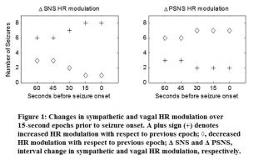HEART RATE MODULATION IN TEMPORAL LOBE SEIZURES
Abstract number :
3.180
Submission category :
Year :
2005
Submission ID :
5986
Source :
www.aesnet.org
Presentation date :
12/3/2005 12:00:00 AM
Published date :
Dec 2, 2005, 06:00 AM
Authors :
Alexis Boro, Fred Lado, and Solomon Moshe
Temporal lobe seizures often differentially affect sympathetic and vagal heart rate modulation. The time course of these effects has not been fully determined. The hour before through the hour after seizures in 4 patients with TL epilepsy (11 to 42 years old; 3 female, 1 male; right- sided onset seizures in 2, left-sided onset in 2) were studied. RR intervals were interpolated with a cubic spline function and highpass filtered. Wavelet coefficients were determined from the continuous wavelet transform and converted to amplitudes with the Hilbert transform. Changes in sympathetic and vagal HR modulation were inferred from changes in high frequency (HF, 0.15-0.5 Hz) and low frequency (LF, 0.04-0.15 Hz) power from the following rules: a change in vagal activity is reflected by a change in HF and LF power in that direction, a change in sympathetic activity is reflected in HF activity in that direction, and changes in the LF/HF ratio resolve ambiguous patterns arising from simultaneous changes in sympathetic and vagal HR modulation. Nine complex partial seizures were recorded: 4 secondarily generalized (left onset in 3, right in 1) and 5 did not (left onset in 2, right in 3).
Pre-ictal HR modulations attributable to seizures were small in relation to background fluctuations. The number of seizures showing increased sympathetic and decreased vagal HR modulation increased as the seizure approached (Fig 1). 8/9 seizures demonstrated ictal tachycardia (mean pre-ictal HR + 3 SD). All were associated with a very low frequency peak (0.004-0.04 Hz), on average exceeding the pre-ictal baseline by 4.8 SD. This peak was coincident with LF and HF minima, and corresponds to sustained sympathetically mediated acceleration of the HR.
In the post-ictal period, in 8/9 seizures vagal HR modulation was at least transiently lower in the post-ictal state than in any of the points in a reference state composed of a random sampling of 20% of the points on the HF and LF curves in the pre-ictal period. Secondarily generalized seizures were associated with longer periods of this degree of vagal depression than complex partial seizures (mean 26 vs. 11 min): limited data suggested that LF HRV and respiratory frequency were uncoupled in this period. Increased post-ictal sympathetic HR modulation was often evident, but was less extreme and of a shorter duration. These preliminary data suggest that increased sympathetic and decreased vagal HR modulation often precede the electroclinical onset and ictus of TL seizures. The post-ictal period is characterized by decreased vagal HR modulation that persists for considerably longer after secondarily generalized seizures.[figure1] (Supported by Rett Syndrome Research Foundation.)
